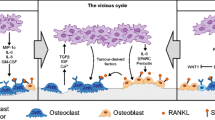Abstract
Twenty five hormone manipulated patients with prostate cancer and metastatic bone disease, treated at least 6/12 previously by hormone manipulation, were given intravenous infusions of Disodium Pamidronate (APD) over a 6 month period. Patients received 30 mg weekly for 4 weeks then twice monthly for 5 months. No other treatment was administered during study. Eleven of 17 patients with pain at the start of the study were pain free at the end. Fasting morning calcium excretion and serum osteocalcin fell significantly with Pamidronate (P less than 0.0001) and urine hydroxyproline was lowered in 13/20 evaluable patients at 6 months. Alkaline phosphatase fell in a proportion of patients and five of 17 patients with previously progressive bone scans stabilised (4) or regressed (1) on treatment. Rising acid phosphatase levels were also lowered in five patients. It is concluded that Pamidronate may be effective in palliating bone pain in some patients and has a stabilising influence on abnormally high bone turnover in metastatic prostate cancer. Further controlled studies of the compound are now warranted.
Similar content being viewed by others
Author information
Authors and Affiliations
Rights and permissions
About this article
Cite this article
Clarke, N., Holbrook, I., McClure, J. et al. Osteoclast inhibition by pamidronate in metastatic prostate cancer: a preliminary study. Br J Cancer 63, 420–423 (1991). https://doi.org/10.1038/bjc.1991.97
Issue Date:
DOI: https://doi.org/10.1038/bjc.1991.97
- Springer Nature Limited
This article is cited by
-
Advances in the use of bisphosphonates in the prostate cancer setting
Prostate Cancer and Prostatic Diseases (2004)
-
The role of bisphosphonates in the management of metastatic prostate cancer
Current Oncology Reports (2003)
-
The potential role of bisphosphonates in prostate cancer
Prostate Cancer and Prostatic Diseases (2002)
-
Utility of bisphosphonates in treating bone metastases
Medical Oncology (1996)




